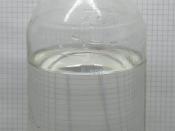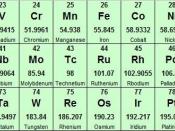Metals are elements that have certain properties and react with several different things. Some metals react with oxygen, some with water, some with hydrochloric acid, and several other things. Also, some elements react more readily than others, and they react at different speeds. Many metals are good conductors of heat and electricity, and they are malleable and ductile. Malleable means that the metal can be formed into a certain shape and it will stay in the same shape, and ductile means that they can be formed and shaped into wires. Metals are solids (except for mercury and gallium), and they tend to be very strong and can hold big masses and weights.
Now, in 1869,a man by the name of Mendeleev classified the metals and other elements into what is now known as the Periodic Table. He classified them into eight groups and a section called the Transition Metals. In Group I, these are the most reactive elements; there are mostly all metals except for Hydrogen. In Group II, there are only metals, and then there are the Transition Metals, which are, of course, only metals. In Groups III and IV, there are a few metals, and there are two in Group V and one in Group VI. As the numbers of the groups get higher, the less reactive the metals are.
The first metals were discovered in 5000 B.C. These metals were Gold and Copper. Both of which are in the Transition Metals, in the group called VIII B. Gold was discovered first by somebody who remains unknown. How it was found, we don't know either, but we believe that it was found on the ground in little nuggets of gold, in sand or on a riverbed. Gold is found as a native element, which means...


